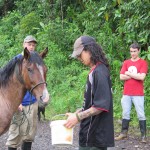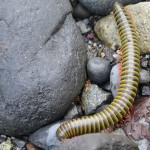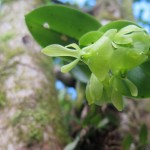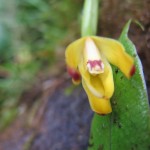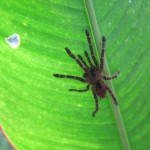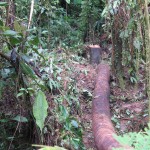Hello, again, from Pastaza, Ecuador.
As many, if not all, will know, recently the country was hit by a major earthquake on the coastal regions causing great damage, with over 600 people killed and thousands more injured and many more made homeless. Terrible and very sad news! The situation is dire for many people and if you wish more information, please check out on-line.
Tremors were felt here in Puyo and around the region, although there was little or no damage caused.
On the land, we are delighted to welcome Ramon, from near Barcelona, Spain, who has joined us for a few months. He has very quickly fitted into the team and has been a great help – assisting with more cleaning and clearing of the land around the pond and the clinic, moving up sand and stones to help with the construction of the toilet/shower, and planting out of the donated plants and others grown from seed, as well as spending time investigating the land and visiting other areas of Ecuador.
The Tamarin Monkeys have been spotted on and around the land again, and we now believe that there may be more than one group and possibly more than one species. At least two, small, family groups have been seen (one with three members, the other with five) and we are fairly confident one is the Black-mantled Tamarin Monkey (Saguinus nigricollis), and the other is the Brown-mantled Tamarin Monkey (Saguinus fuscicollis)……to be confirmed.
The toucans continue to be seen and heard around the land and this month’s snakes include a Speckled Forest Pit Viper, a Hog-nosed Viper, another Cat-eyed Snake and one of the many false coral species to be found in the area.
Another, as yet unidentified, species of bird has been seen. All we can say at this stage was that an ‘orange’ bird of approximately tanager dimensions (around 13-15cm in length) was briefly glimpsed a couple of weeks ago.
Returning to the issue of the mysterious tiny humming bird – mentioned in the last update………..at least two members of the Fundación (Omar from the Jardín Botánico Las Orquídeas, and Adrianna from the Mariposario in Mera) have confirmed seeing similarly described bee-sized humming birds, one about 12 kilometres from our site, the other about 25 kilometres away; and Laura from the Arajuno Road Project has also seen another very small, unidentified humming bird with different colouration in another area relatively close-by……….to be continued.Unusually, a small group of yellow-headed vultures was noted low down in some trees last week, and following them and the smell that had obviously attracted them, we found the body of a recently killed Guanta (Lowland Paca – Cuniculus paca) near a path. It was possibly killed by a snake, as a larger predator would have removed and eaten the body. Guantas are large rodents (weighing between six and twelve kilograms usually) and although not considered endangered, are much reduced in number due to hunting and habitat destruction.
Unfortunately, we have had some other, unwelcome, visitors to the land in April – some Sangre de Drago robbers……….Sangre de Drago is a tree species that produces a red (blood-coloured) sap that has sought-after medicinal qualities. At about mid-day, a couple of weeks ago, we heard the sound of a tree come down on the Fundacion’s land – we didn’t think anything of it at first. Just a tree-fall (not uncommon), we thought, and as it was raining at the time, we didn’t investigate further.
Then, about twenty minutes later we heard the sound of machetes being used around the same area. Then, about half an hour after this, we heard what seemed to be another tree come down, this time a little farther away.
Meantime, Glen was investigating on our land after a second tree came down there and came across two people hiding behind trees. They managed to make off.
Continuing to investigate, while on the road below, a car (never seen before) passed with a group of strangers in it. Glen managed to stop them farther down the road, and they of course, knew nothing! Just after this however, Glen spotted another young guy, gave chase, however, the stranger was quite far away and he escaped.
On investigation, we discovered that the people had cut down at least two mature Sangre de Drago trees and had made circular cuts in the trunks to allow the sap to run free and be collected. Sangre de Drago are fast-growing secondary forest trees and are not currently endangered, however, they are valuable in their own right and also as providers of habitat for many other plant and animal species. Of course, other neighbouring plants are also damaged as the trees fall! We have started to rescue some of the many canopy orchids and bromeliads that were on the trees, and hopefully we can repair some of the damage done.
Our suspicion is that these people won’t be back now they know they have been spotted (we think that they thought the land was not lived on) – we certainly hope so. And we don’t think that they are locals – we didn’t recognise any of them. Ho hum much………….!

